Tribological Behavior of Lamellar Molybdenum Trioxide as a Lubricant Additive
Abstract
:1. Introduction
2. Experimental Details
2.1. Friction and Wear Tests
2.2. Characterization
2.3. Lubrication Preparation
3. Results and Discussion
3.1. Influence of the Concentration of MoO3
3.2. Influence of the Normal Load and Velocity
3.3. Stribeck Curves
3.4. Influence of the Temperature
3.5. Influence of the Particle Sizes
4. Conclusions
Author Contributions
Funding
Acknowledgments
Conflicts of Interest
References
- Chen, F.X.; Mai, Y.J.; Xiao, Q.N.; Cai, G.F.; Zhang, L.Y.; Liu, C.S.; Jie, X.H. Three-dimensional graphene nanosheet films towards high performance solid lubricants. App. Surf. Sci. 2019, 467–468, 30–36. [Google Scholar] [CrossRef]
- Wu, H.; Wang, L.; Johnson, B.; Yang, S.; Zhang, J.; Dong, G. Investigation on the lubrication advantages of MoS2 nanosheets compared with ZDDP using block-on-ring tests. Wear 2018, 394–395, 40–49. [Google Scholar] [CrossRef]
- Hsu, C.; Hou, K.; Ger, M.; Wang, G. The effect of incorporated self-lubricated BN(h) particles on the tribological properties of Ni–P/BN(h) composite coatings. App. Surf. Sci. 2015, 357, 1727–1735. [Google Scholar] [CrossRef]
- Xu, Y.; Geng, J.; Peng, Y.; Liu, Z.; Yu, J.; Hu, X. Lubricating mechanism of Fe3O4@MoS2 core-shell nanocomposites as oil additives for steel/steel contact. Tribol. Int. 2018, 121, 241–251. [Google Scholar] [CrossRef]
- Furlan, K.P.; Mello, J.D.B.; Klein, A.N. Self-lubricating composites containing MoS2: A review. Tribol. Int. 2018, 120, 280–298. [Google Scholar] [CrossRef]
- Berman, D.; Erdemir, A.; Sumant, A.V. Reduced wear and friction enabled by graphene layers on sliding steel surfaces in dry nitrogen. Carbon 2013, 59, 167–175. [Google Scholar] [CrossRef]
- Gong, K.; Wu, X.; Zhao, G.; Wang, X. Nanosized MoS2 deposited on graphene as lubricant additive in polyalkylene glycol for steel/steel contact at elevated temperature. Tribol. Int. 2017, 110, 1–7. [Google Scholar] [CrossRef]
- He, X.L.; Xiao, H.P.; Jonathan, P.K.; Elon, J.T.; Liang, H. Two-dimensional nanostructured Y2O3 particles for viscosity modification. Appl. Phys. Lett. 2014, 104, 221–234. [Google Scholar] [CrossRef]
- Ingole, S.; Charanpahari, A.; Kakade, A.; Umare, S.S.; Bhatt, D.V. Tribological behavior of nano TiO2 as an additive in base oil. Wear 2013, 301, 776–785. [Google Scholar] [CrossRef]
- Battez, A.H.; Gonza’lez, R.; Viesca, J.L.; Ferna’ndez, J.E.; Ferna’ndez, J.M.D.; Machado, A.; Chou, R.; Riba, J. CuO, ZrO2 and ZnO nanoparticles as antiwear additive in oil lubricants. Wear 2008, 265, 422–428. [Google Scholar] [CrossRef]
- Battez, A.H.; Viesca, J.L.; Gonza’lez, R.; Blanco, D.; Asedegbega, E.; Osorio, A. Friction reduction properties of a CuO nanolubricant used as lubricant for a NiCrBSi coating. Wear 2010, 268, 325–328. [Google Scholar] [CrossRef]
- Huang, W.; Wang, X.; Ma, G.; Shen, C. Study on the synthesis and tribological property of Fe3O4 based magnetic fluids. Tribol. Lett. 2009, 33, 187–192. [Google Scholar] [CrossRef]
- Wu, H.; Zhao, J.; Xia, W.; Cheng, X.; He, A.; Yun, J.; Wang, L.; Huang, H.; Jiao, S.; Huang, L.; et al. A study of the tribological behaviour of TiO2 nano-additive water-based lubricants. Tribol. Int. 2017, 109, 398–408. [Google Scholar] [CrossRef]
- Radice, S.; Mischler, S. Effect of electrochemical and mechanical parameters on the lubrication behaviour of Al2O3 nanoparticles in aqueous suspensions. Wear 2006, 261, 1032–1041. [Google Scholar] [CrossRef]
- Xiao, H.; Liu, S. 2D nanomaterials as lubricant additive: A review. Mater. Des. 2017, 135, 319–332. [Google Scholar] [CrossRef]
- Dai, W.; Kheireddin, B.; Gao, H.; Kan, Y.; Clearfield, A.; Liang, H. Formation of anti-wear tribofilms via α-ZrP nanoplatelet as lubricant additives. Lubricants 2016, 4, 28. [Google Scholar] [CrossRef]
- Sreedhara, M.B.; Matte, H.S.S.R.; Govindaraj, A.; Rao, C.N.R. Synthesis, characterization, and properties of few-layer MoO3. Chem. Asian J. 2013, 8, 2430–2435. [Google Scholar] [CrossRef] [PubMed]
- Balendhran, S.; Walia, S.; Nili, H.; Ou, J.Z.; Zhuiykov, S.; Kaner, R.B.; Sriram, S.; Bhaskaran, M.; Kalantar-zadeh, K. Two-Dimensional molybdenum trioxide and dichalcogenides. Adv. Funct. Mater. 2013, 23, 3952–3970. [Google Scholar] [CrossRef]
- Wang, B.B.; Qu, X.L.; Zhu, M.K.; Chen, Y.A.; Zheng, K.; Zhong, X.X.; Cvelbar, U.; Ostrikov, K. Plasma produced photoluminescent molybdenum sub-oxide nanophase materials. J. Alloys Comp. 2018, 765, 1167–1173. [Google Scholar] [CrossRef]
- He, X.; Xiao, H.; Choi, H.; Díaz, A.; Mosby, B.; Clearfield, A.; Liang, H. α-Zirconium phosphate nanoplatelets as lubricant additives. Colloids Surf. A Physicochem. Eng. Asp. 2014, 452, 32–38. [Google Scholar] [CrossRef]
- Zhang, W.; Zhou, M.; Zhu, H.; Tian, Y.; Wang, K.; Wei, J.; Ji, F.; Li, X.; Li, Z.; Zhang, P. Tribological properties of oleic acid-modified graphene as lubricant oil additives. J. Phys. D. Appl. Phys. 2011, 44, 1–4. [Google Scholar] [CrossRef]
- Zhang, S.; Pan, Q.; Yan, J.; Huang, X. Effects of sliding velocity and normal load on tribological behavior of aged Al-Sn-Cu alloy. T. Nonferr. Metal. Soc. 2016, 26, 1809–1819. [Google Scholar] [CrossRef]
- Zhou, Q.; Huang, J.; Wang, J.; Yang, Z.; Liu, S.; Wang, Z.; Yang, S. Preparation of a reduced graphene oxide/zirconia nanocomposite and its application as a novel lubricant oil additive. RSC Adv. 2015, 5, 91802–91812. [Google Scholar] [CrossRef]
- Mohamed, K.A.A.; Hou, X.; Mai, L.; Cai, Q.; Turkson, R.; Chen, B. Improving the tribological characteristics of piston ring assembly in automotive engines using Al2O3 and TiO2 nanomaterials as nano-lubricant additives. Tribol. Int. 2016, 103, 540–554. [Google Scholar] [CrossRef]
- Han, Y.; Qiao, D.; Sun, L.; Feng, D. Functional alkylimidazolium ionic liquids as lubricants for steel/aluminum contact: Influence of the functional groups on tribological performance. Tribol. Int. 2018, 119, 766–774. [Google Scholar] [CrossRef]
- Liu, D.; Yan, B.; Shen, B.; Liu, L.; Hu, W. Friction behaviors of rough chromium surfaces under starving lubrication conditions. App. Surf. Sci. 2018, 427, 857–862. [Google Scholar] [CrossRef]
- Ruggiero, A.; D’Amato, R.; Merola, M.; Valašek, P.; Müller, M. Tribological characterization of vegetal lubricants: Comparative experimental investigation on Jatropha curcas L. oil, Rapeseed Methyl Ester oil, Hydrotreated Rapeseed oil. Tribol. Int. 2017, 109, 529–540. [Google Scholar] [CrossRef]
- Stribeck, R. Kugellager für Beliebige Belastungen, Zeitschrift des Vereins Deutscher Ingenieure; Nr. 3, Band 45; Rudolph Gaertner: Berlin, Germany, 1901; pp. 73–79. [Google Scholar]
- Jacobson, B. The stribeck memorial lecture. Tribol. Int. 2003, 36, 781–789. [Google Scholar] [CrossRef]
- Liu, L.; Yang, C.; Sheng, Y. Wear model based on real-time surface roughness and its effect on lubrication regimes. Tribol. Int. 2018, 126, 16–20. [Google Scholar] [CrossRef]
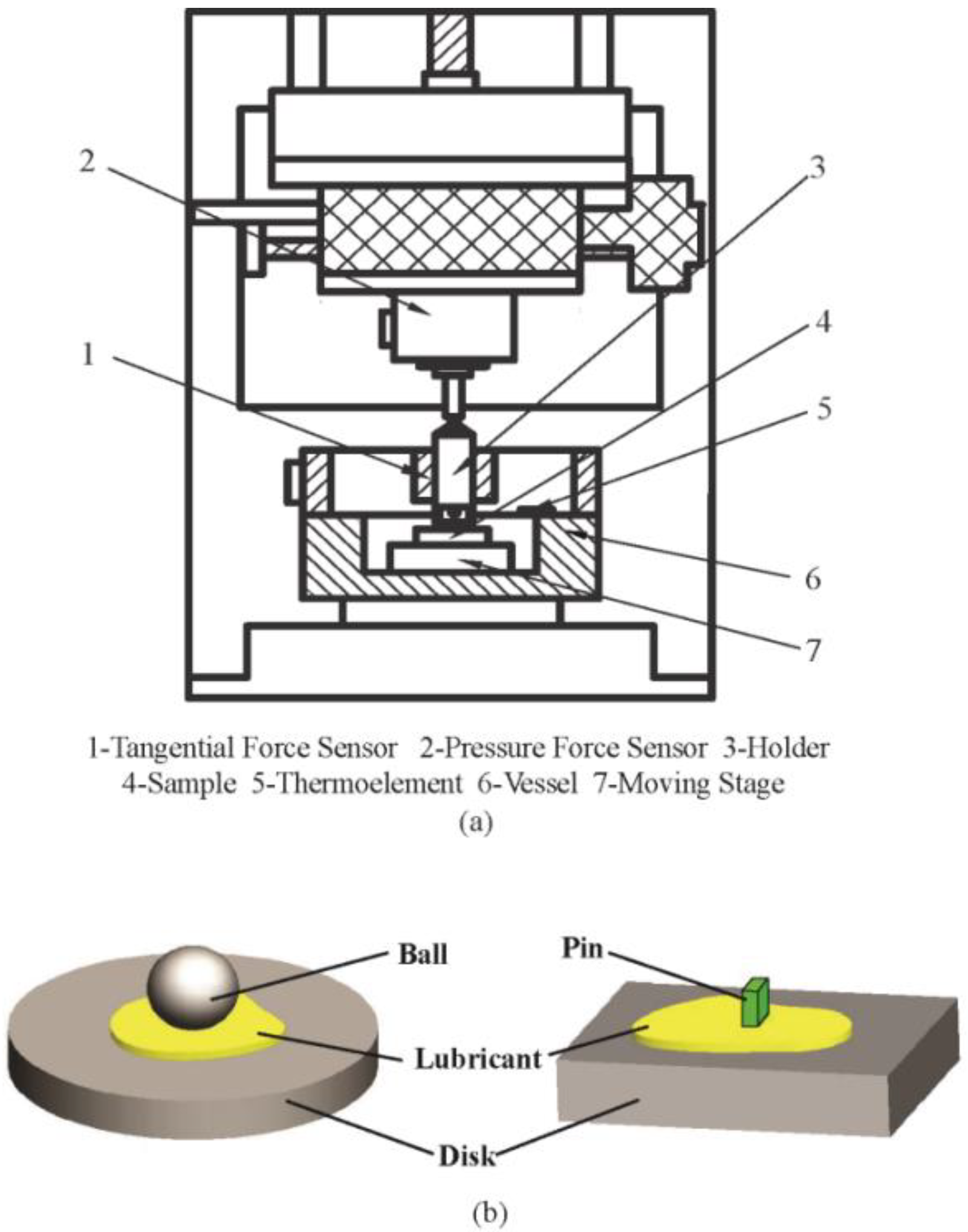
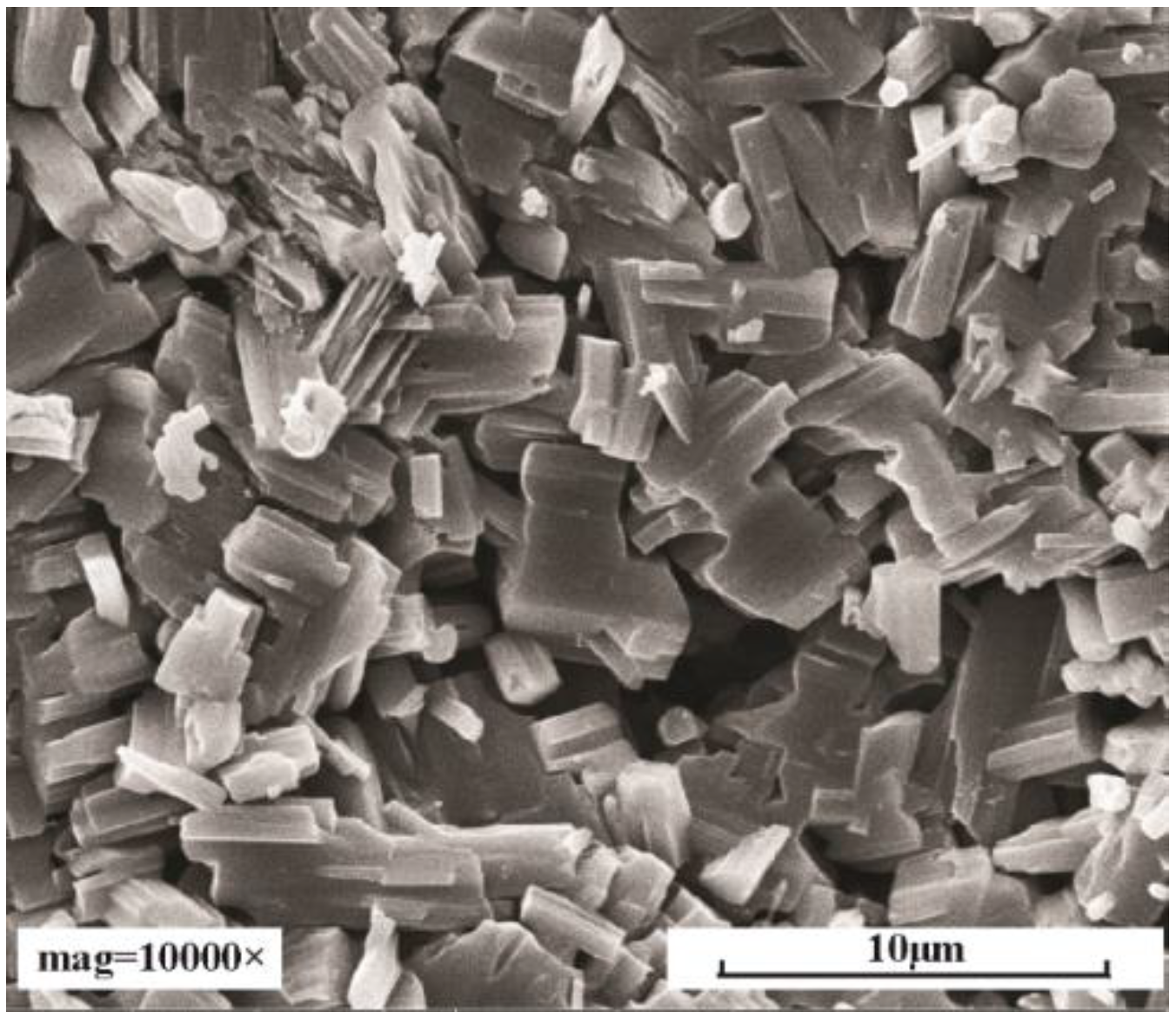
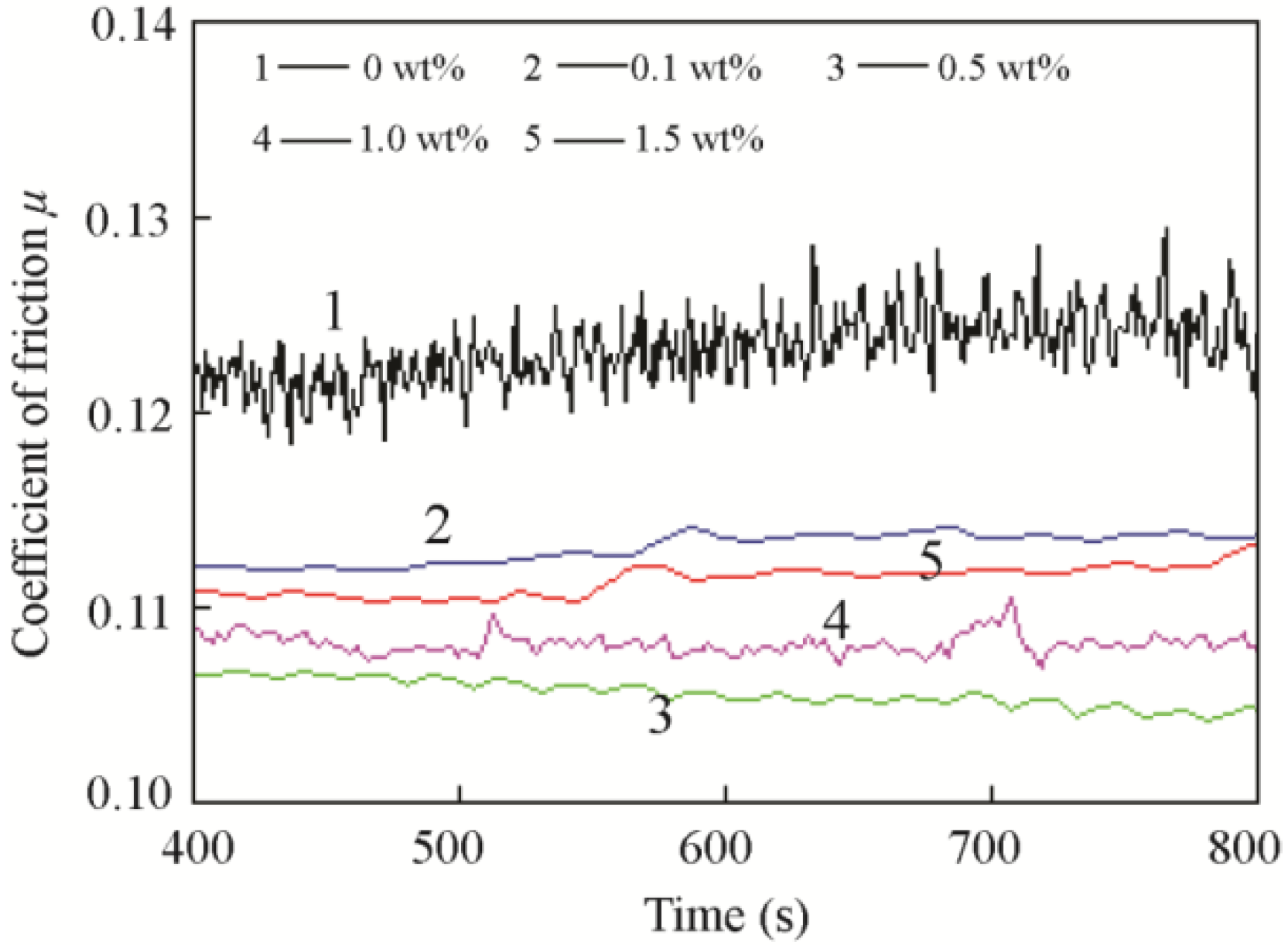




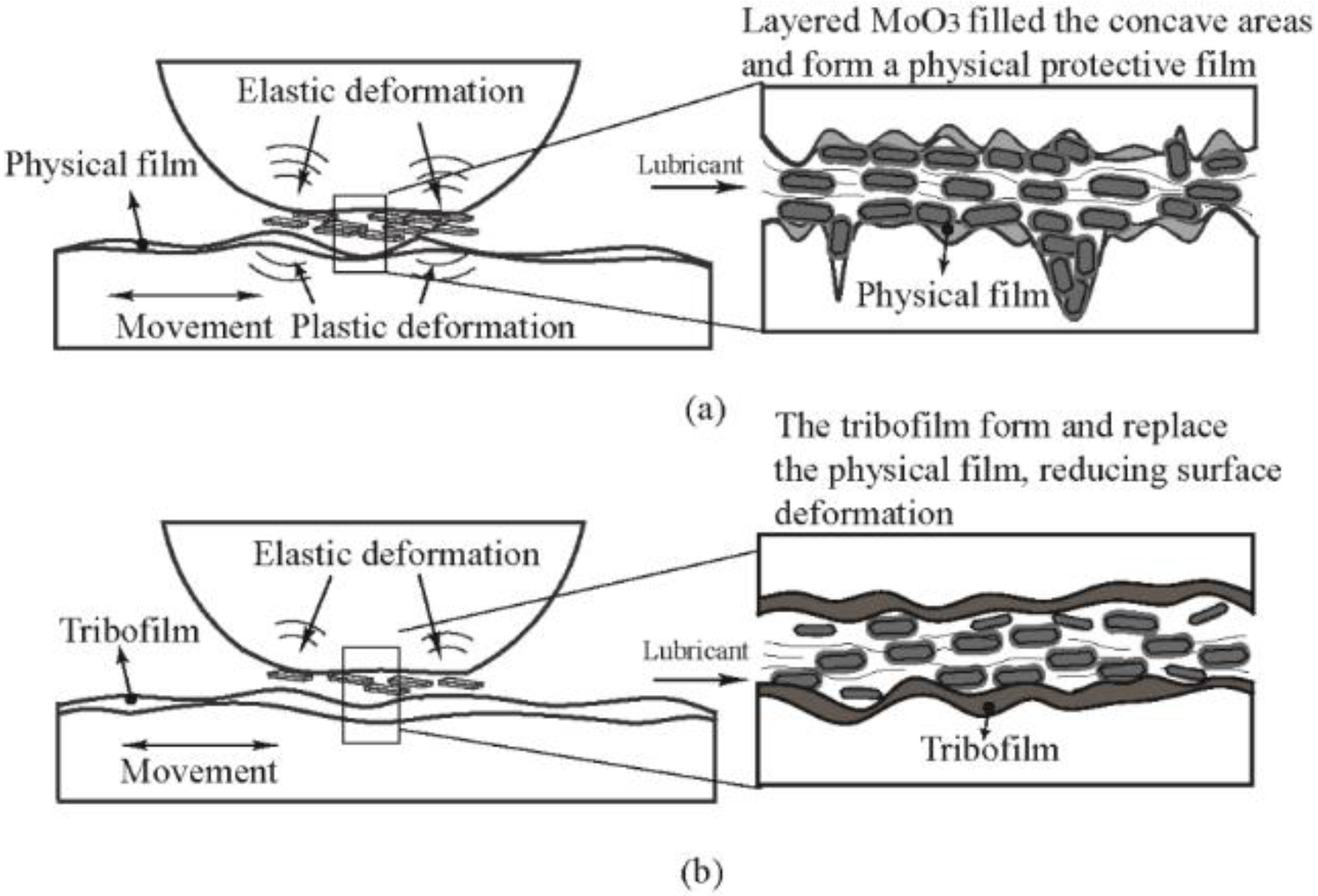
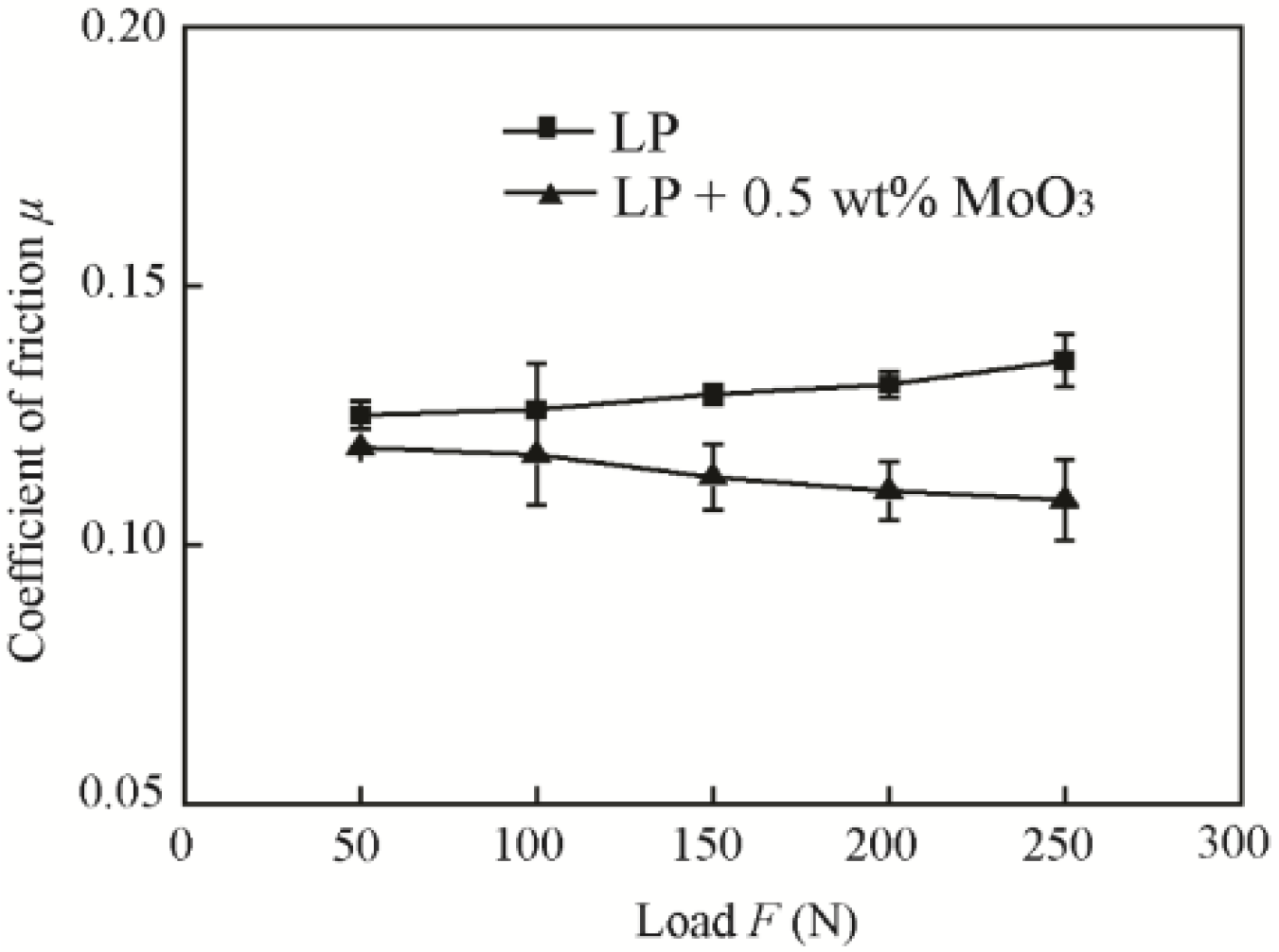

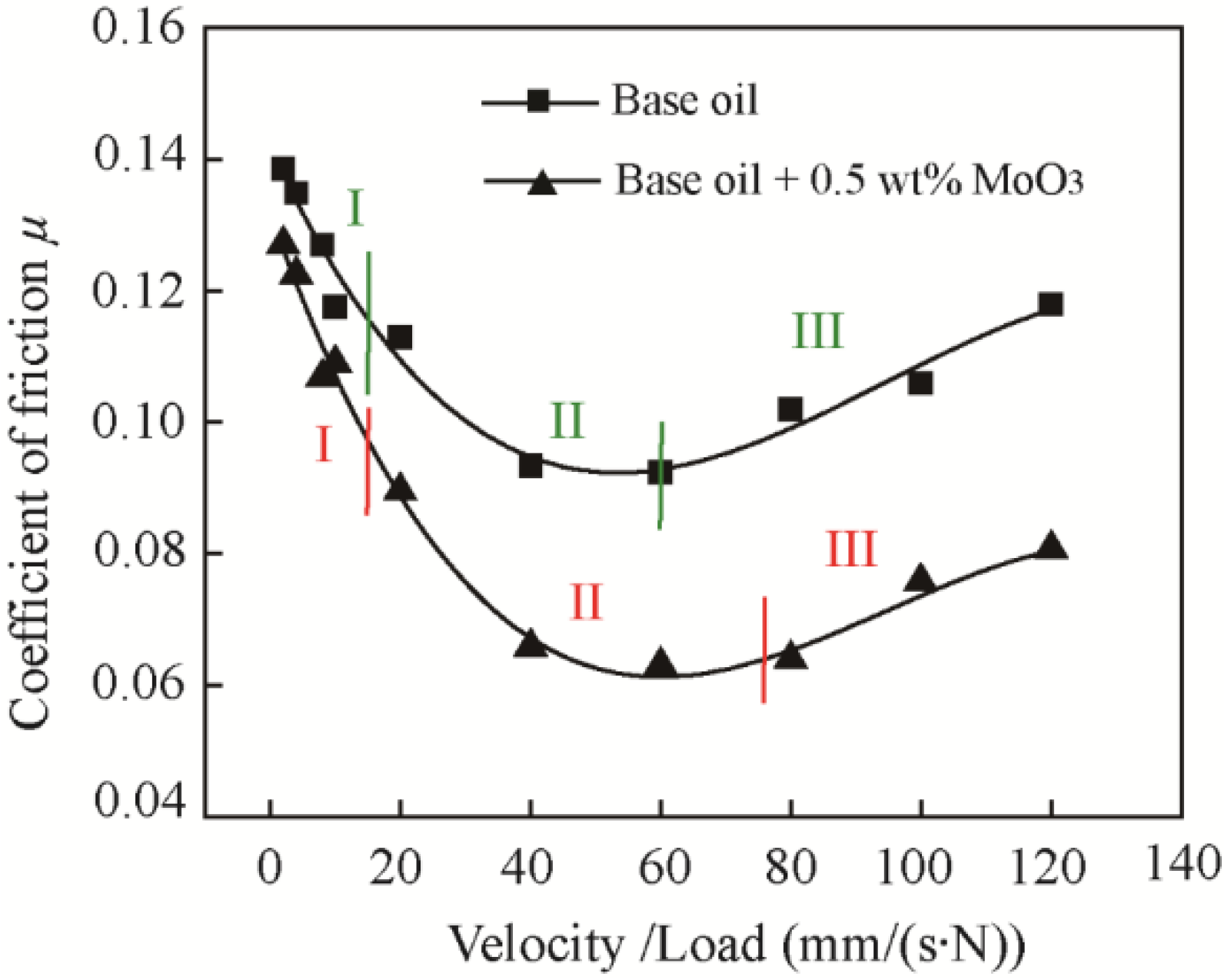


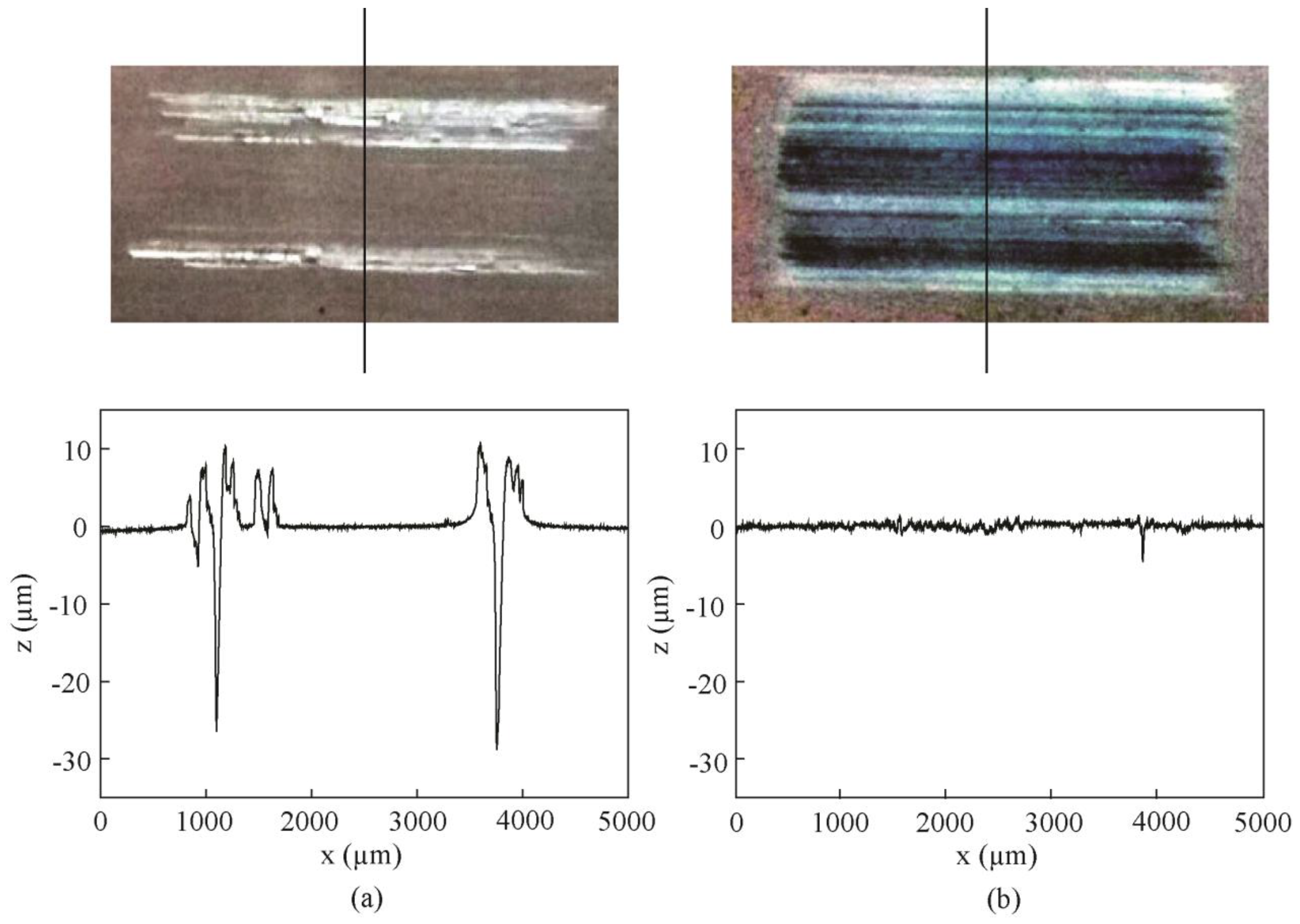

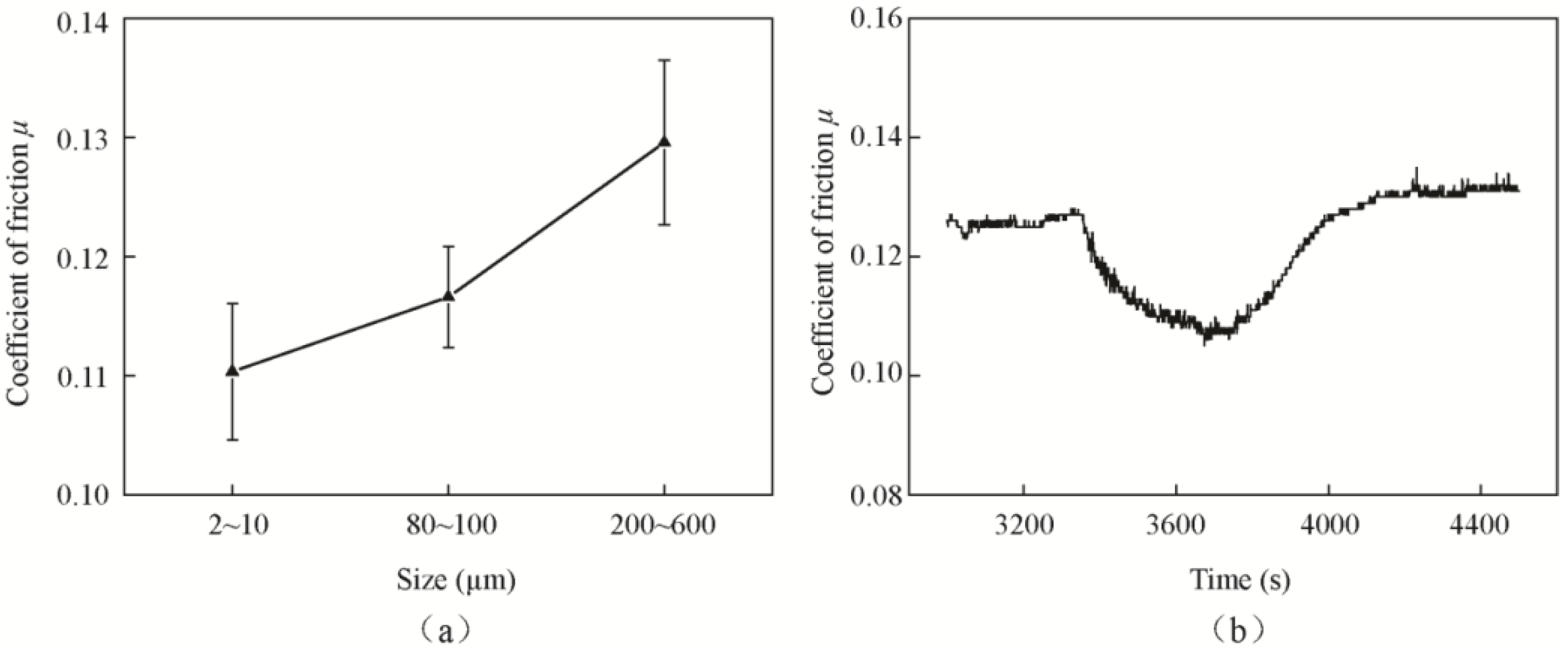

| Material | Tensile Strength (MPa) | Yield Strength (MPa) | Hardness | Size (mm) Length × Width × Height | Arithmetical Mean Roughness Ra (μm) | ||
|---|---|---|---|---|---|---|---|
| Pin-on-disk | Pin | GCr15 | 861 | 518 | 30 HRC | 5 × 2 × 5 | 0.06 |
| disk | GCr15 | 861 | 518 | 30 HRC | 43 × 32 × 7 | 0.034 | |
| Ball-on-disk | Ball | 9Cr18 | 741 | 295 | 58 HRC | ϕ 10 | - |
| disk | 1Cr18Ni9Ti | 680 | 265 | 158 HB | ϕ 40 × 10 | 0.034 | |
| C | Si | Mn | Cr | Ni | S | P | |
|---|---|---|---|---|---|---|---|
| GCr15 | 1.01 | 0.25 | 0.35 | 1.46 | - | 0.002 | 0.012 |
| 9Cr18 | 1.03 | 0.39 | 0.47 | 18.3 | 0.16 | 0.003 | 0.008 |
| 1Cr18Ni9Ti | 0.04 | 0.12 | 1.22 | 17.65 | 8.24 | 0.01 | 0.009 |
| Concentrations (wt %) | 0 | 0.1 | 0.5 | 1.0 | 1.5 | p |
|---|---|---|---|---|---|---|
| Coefficient of friction | 0.127 ± 0.003 a | 0.119 ± 0.004 b | 0.108 ± 0.005 c | 0.116 ± 0.009 d | 0.118 ± 0.008 d | 0.0026 |
| Concentrations (wt %) | 0/0.1 | 0.1/0.5 | 0.5/1.0 | 1.0/1.5 |
|---|---|---|---|---|
| p | 0.0115 | 0.0174 | 0.034 | 0.825 |
© 2018 by the authors. Licensee MDPI, Basel, Switzerland. This article is an open access article distributed under the terms and conditions of the Creative Commons Attribution (CC BY) license (http://creativecommons.org/licenses/by/4.0/).
Share and Cite
Tang, W.; Liu, R.; Lu, X.; Zhang, S.; Liu, S. Tribological Behavior of Lamellar Molybdenum Trioxide as a Lubricant Additive. Materials 2018, 11, 2427. https://doi.org/10.3390/ma11122427
Tang W, Liu R, Lu X, Zhang S, Liu S. Tribological Behavior of Lamellar Molybdenum Trioxide as a Lubricant Additive. Materials. 2018; 11(12):2427. https://doi.org/10.3390/ma11122427
Chicago/Turabian StyleTang, Wei, Rui Liu, Xiangyong Lu, Shaogang Zhang, and Songyong Liu. 2018. "Tribological Behavior of Lamellar Molybdenum Trioxide as a Lubricant Additive" Materials 11, no. 12: 2427. https://doi.org/10.3390/ma11122427
APA StyleTang, W., Liu, R., Lu, X., Zhang, S., & Liu, S. (2018). Tribological Behavior of Lamellar Molybdenum Trioxide as a Lubricant Additive. Materials, 11(12), 2427. https://doi.org/10.3390/ma11122427






